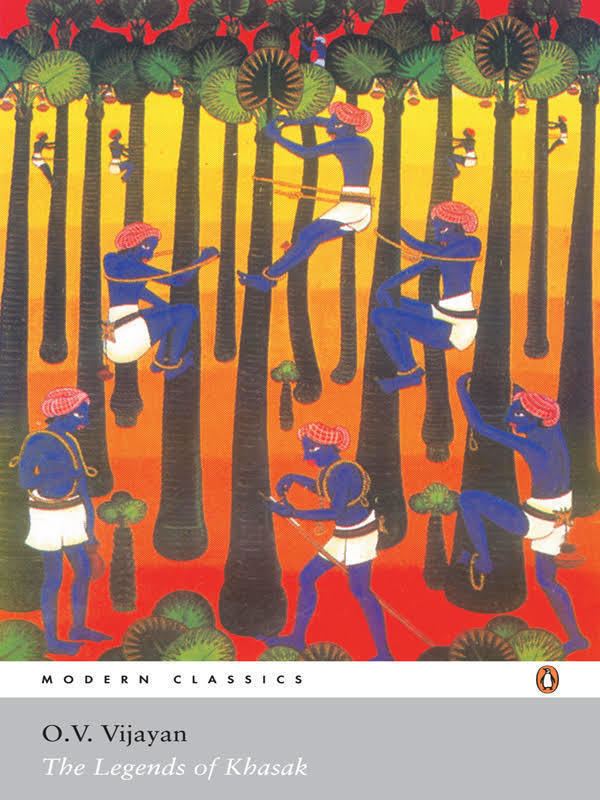ISBN 978-8171301263 Genre Novel Country India | Originally published 1 January 1990 Original language Malayalam Publisher DC Books | |
 | ||
Similar Dravidian languages books, Novels | ||
Khasakkinte Ithihasam (Malayalam:ഖസാക്കിന്റെ ഇതിഹാസം) is a Malayalam novel written by the Indian writer O. V. Vijayan. First published in 1969 and generally referred to as Khasak in literary circles, the novel has been reprinted more than fifty times, making it one of the most best-selling novels in South Asia.
Contents
Khasakkinte Itihasam has been translated into French, German and English (the last by the author himself, published in 1994 under the title The Legends of Khasak, and differing substantially from the original in its sensibility - most readers prefer to read it as an independent novel by Vijayan in English rather than seeing it as a translation).
Plot
Khasakkinte Itihasam does not have a single narrative plot. It is crafted in the form of the spiritual journey of an under-graduate dropout, Ravi, plagued by the guilt of an illicit affair he had with his stepmother. Ravi abandons a bright academic career and a research offer from Princeton University. He deserts his lover Padma and leaves on a long pilgrimage, which finally brings him to the small hamlet of Khasak near Palakkad. At Khasak, he starts a single-teacher school as part of the District Board’s education initiative. The novel begins with Ravi’s arrival at Khasak and his encounters with its people, Allappicha Mollakka, Appukkili, Shivaraman Nair, Madhavan Nair, Kuppuvachan, Maimoona, Khaliyar, Aliyar, and the students of his school like Kunhamina, Karuvu, Unipparadi, Kochusuhara and others. After some years, his lover Padma calls on him and Ravi decides to leave Khasak. He commits suicide through snake-bite while waiting for a bus at Koomankavu.
The novel has no story-line per se. It recounts the numerous encounters of Khasak from a spiritual and philosophical frame of mind. Through these encounters, Vijayan narrates numerous stories, myths and superstitions cherished in Khasak. He places them in opposition to the scientific and rational world outside, which is now making inroads into the hamlet through Ravi's single-teacher school. The irony of the interface between these two worlds occupies a substantial space in the novel. Through the myths and stories, Vijayan also explores similar encounters of the past recounted by the people of Khasak, enabling him to have a distinctly unique view of cultural encounters across time and space.
Background
Khasakkinte Itihasam was inspired by Vijayan's stay at a village called Thasarak near Palakkad for a year. His sister O.V. Shanta was appointed as the teacher of a single-teacher school in the village. Most of the characters in the novel were modelled after real-life characters whom Vijayan encountered in Thasarak. In an afterword to the English translation of the novel Vijayan wrote:
It had all begun this way: in 1956 my sister got a teaching assignment in the village of Thasarak. This was part of a State scheme to send barefoot graduates to man single-teacher schools in backward villages.
Since it was hard for a girl to be on her own in a remote village, my parents had rented a little farmhouse and moved in with my sister. Meanwhile I had been sacked from the college where I taught. Jobless and at a loose end, I too joined them in Thasarak to drown my sorrows.... Destiny had been readying me for Khasak."
Vijayan took twelve years to complete Khasakkinte Itihasam.
The character Appukkili was originally created by Vijayan for his short story "Appukkili" which was published in 1958.
Publication
Khasakkinte Itihasam was serialised in Mathrubhumi weekly in 28 parts, between 28 January 1968 and 4 August 1968. It was published as a book by Current Books in 1969. The first DC Books edition came in 1990.
Reception
Sunil K. Poolani:
T.P. Rajeevan:
Lukose Mathew:
Tarun Tejpal:
K. Satchidanandan:
English translation
Vijayan published his English translation of Khasakkinte Itihasam in 1994, long after he experienced an epistemological break after meeting the monk Swami Karunakara Guru. The early Vijayan was marked by deep philosophical doubt and skepticism, but the later Vijayan upheld certitudes. The Legends of Khasak was written by the Vijayan of certitudes, which makes it a very different novel in its sensibility, in spite of being a translation. One critic makes the following comparison between Khasakkinte Itihasam and The Legends of Khasak to prove this point. A literal translation of an important passage in Khasakkinte Itihasam reads:
In The Legends of Khasak, Vijayan rendered this passage thus:
Some critics divide Malayalam literature into works written before Khasak and after Khasak.
